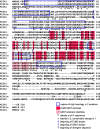Differential HDAC1 and 2 Recruitment by Members of the MIER Family
- PMID: 28046085
- PMCID: PMC5207708
- DOI: 10.1371/journal.pone.0169338
Differential HDAC1 and 2 Recruitment by Members of the MIER Family
Abstract
The mier family consists of three related genes encoding ELM2-SANT containing proteins. MIER1 has been well characterized and is known to function in transcriptional repression through its ability to recruit HDAC1 and 2. Little is known about MIER2 or MIER3 function and no study characterizing these two proteins has been published. In this report, we investigate MIER2 and MIER3 localization and function. Confocal analysis revealed that, while MIER2 and MIER3 are mainly nuclear proteins, a substantial proportion (32%) of MIER2 is localized in the cytoplasm. Co-immunoprecipitation experiments demonstrated that the MIER proteins do not dimerize; that MIER2, but not MIER3, can recruit HDACs; and that recruitment is cell line-dependent. MIER2 was associated with HDAC1 and HDAC2 in HEK293 cells, but only with HDAC1 in MCF7 and HeLa cells. Little or no MIER3 co-immunoprecipitated with either HDAC1 or 2 in any of the three cell lines tested. By contrast, HDAC1 and 2 were readily detected in MIER1α complexes in all three cell lines. Histone deacetylase assays confirmed that MIER2, but not MIER3 complexes, have associated deacetylase activity, leading to the conclusion that MIER3 does not function in HDAC recruitment in these cell lines. In contrast to what has been reported for other ELM2-SANT associated HDACs, addition of D-myo-inositol-1,4,5,6-tetrakisphosphate led to only a small increase in MIER1α associated deacetylase activity and no effect on that associated with MIER2. Deletion analysis revealed that HDAC recruitment occurs through the ELM2 domain. Finally, using site-directed mutagenesis, we show that, like MIER1, 228W in the ELM2 domain is a critical residue for HDAC recruitment by MIER2.
Conflict of interest statement
The authors have declared that no competing interests exist.
Figures






References
-
- Paterno GD, Li Y, Luchman HA, Ryan PJ, Gillespie LL. cDNA cloning of a novel, developmentally regulated immediate early gene activated by fibroblast growth factor and encoding a nuclear protein. J Biol Chem. 1997;272(41):25591–5. - PubMed
-
- Paterno GD, Ding Z, Lew YY, Nash GW, Mercer FC, Gillespie LL. Genomic organization of the human mi-er1 gene and characterization of alternatively spliced isoforms: regulated use of a facultative intron determines subcellular localization. Gene. 2002;295(1):79–88. - PubMed
-
- Clements JA, Mercer FC, Paterno GD, Gillespie LL. Differential splicing alters subcellular localization of the alpha but not beta isoform of the MIER1 transcriptional regulator in breast cancer cells. PLoS One. 2012;7(2):e32499 Epub 2012/03/03. PubMed Central PMCID: PMC3286477. 10.1371/journal.pone.0032499 - DOI - PMC - PubMed
MeSH terms
Substances
LinkOut - more resources
Full Text Sources
Other Literature Sources
Molecular Biology Databases
Miscellaneous

